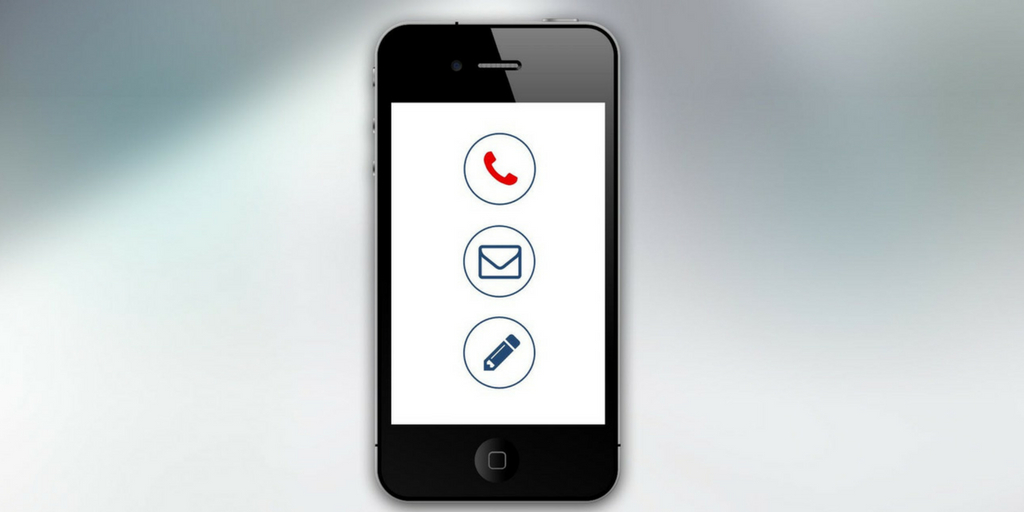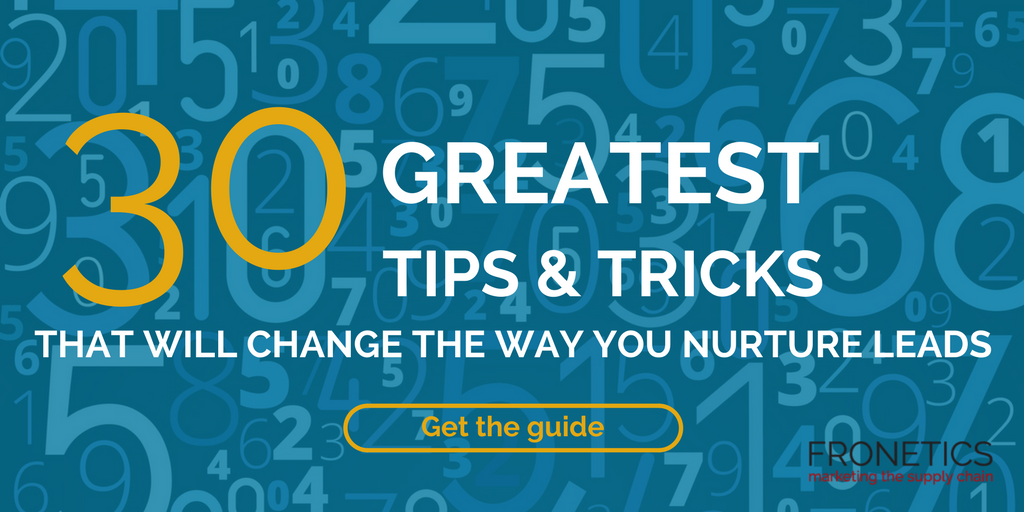
by Fronetics | Jul 16, 2018 | Blog, Content Marketing, Logistics, Marketing, Strategy, Supply Chain
Updated December 11, 2024
Whether you’re selling manufacturing solutions, logistics services, or technology, your supply chain lead generation strategy must address specific industry pain points like inventory optimization, transportation costs, and supplier relationship management.
While content marketing works across industries, supply chain decision-makers have unique needs. Procurement managers, logistics directors, and supply chain VPs face complex challenges:
- Multi-stakeholder buying committees
- Long sales cycles (often 12-18 months)
- High-value purchasing decisions
- Complex technical requirements
- Regulatory compliance concerns
- Integration with existing systems
Let’s explore how to adapt the four core components of lead generation specifically for supply chain audiences.
The 4 Essential Components of Supply Chain Lead Generation
1. Creating High-Value Supply Chain Offers
Supply chain professionals seek concrete solutions to operational challenges. Effective offers include:
Industry Reports:
- Annual logistics cost benchmarking studies
- Regional supplier capability assessments
- Port congestion and capacity forecasts
- Last-mile delivery performance analysis
Technical Resources:
- Warehouse automation ROI calculators
- Transportation management system comparison guides
- Inventory optimization modeling templates
- Supplier risk assessment frameworks
Educational Content:
- Supply chain sustainability certification programs
- LEAN logistics implementation playbooks
- Digital twin technology adoption guides
- Blockchain in supply chain webinar series
2. Supply Chain-Specific Calls-to-Action (CTAs)
Customize your CTAs to resonate with supply chain roles:
For Procurement:
- “Download Supplier Evaluation Template”
- “Access Vendor Management Toolkit”
- “Calculate Potential Sourcing Savings”
For Logistics:
- “Benchmark Your Warehouse Costs”
- “Map Your Distribution Network”
- “Optimize Your Fleet Performance”
For Supply Chain Technology:
- “Compare TMS Features”
- “Schedule WMS Demo”
- “Download Integration Roadmap”
3. Converting Landing Pages for Supply Chain Professionals
Design landing pages that address industry-specific concerns:
Technical Validation:
- Integration capabilities with ERP systems
- API documentation
- Security certifications
- Compliance standards met
Operational Proof:
- Industry-specific case studies (e.g., automotive, retail, pharmaceuticals)
- Performance metrics (e.g., inventory reduction, on-time delivery improvement)
- Implementation timelines
- ROI calculations
Social Proof:
- Logos of recognized supply chain brands
- Industry awards and certifications
- Partnership badges (SAP, Oracle, etc.)
- Client testimonials from supply chain leaders
4. Strategic Form Fields for Supply Chain Lead Qualification
Capture information crucial for supply chain lead scoring:
Company Profile:
- Annual freight spend
- Number of distribution centers
- Current transportation modes
- Manufacturing locations
- System landscape
Project Context:
- Current supply chain challenges
- Priority initiatives
- Decision timeline
- Budget range
- Required integrations
Role Information:
- Position in supply chain organization
- Purchase authority level
- Technology decision-making role
- Geographic responsibility
Supply Chain Lead Nurturing Strategies
Once you’ve captured leads, nurture them with industry-specific content:
Early Stage:
- Educational content about supply chain trends
- Industry benchmark reports
- Thought leadership webinars
Middle Stage:
- Technical specification sheets
- Implementation guides
- Customer success stories
Late Stage:
- Custom ROI analysis
- Pilot program proposals
- Integration assessment reports
Measuring Supply Chain Lead Generation Success
Track these key metrics:
- Lead-to-opportunity conversion by industry vertical
- Sales cycle length for different solution types
- Implementation success rates
- Customer lifetime value by segment
- ROI achieved by solution category
Next Steps in Your Supply Chain Lead Generation Journey
Over the coming weeks, we’ll explore advanced topics including:
- Supply chain buyer persona development
- Industry-specific content strategies
- Technical validation frameworks
- ROI calculation methodologies
Sign up for updates to get these insights and more on generating and nurturing qualified leads in the manufacturing, distribution, and logistics sectors.
Related posts:

by Fronetics | Jan 15, 2018 | Blog, Marketing
Updated January 2025
Marketing automation can help supply chain marketers become more efficient and more successful in earning and converting leads.
Automation is changing today’s supply chain, and not just because robots and autonomous vehicles are scooting around warehouse floors. Supply chain marketers can use automation to drive efficiency and improve our success rates.
HubSpot recently reported that businesses using marketing automation to nurture leads received a whopping 451% increase in qualified leads. So how can you reap these benefits? Let’s take a quick look at automated marketing applications in supply chain marketing.
How can I use marketing automation for supply chain lead generation?
B2B buyers are increasingly demanding vendors provide personalized experiences throughout the buyer’s journey. That makes marketers’ jobs 1 million times more difficult in having to provide custom lead-nurturing content to all prospects in the database. Enter, marketing automation — a way to automate the process of personalizing leads’ interactions with your business. HubSpot describes marketing automation as “software and tactics that allow companies to buy and sell like Amazon — that is, to nurture prospects with highly personalized, useful content that helps convert prospects to customers and turn customers into delighted customers.”
Examples of ways supply chain marketers might use marketing automation include:
- Chatbots
- Social media scheduling tools
- Thank-you, welcome, and other triggered-by-an-event emails
- Event reminders
- Email workflows
The Evolution of Marketing Automation in Supply Chain
Marketing automation is transforming how supply chain marketers generate and nurture leads. According to Salesforce’s 2023 State of Marketing Report, 71% of marketers report significant productivity improvements through automation implementation.
Current State of Automation Adoption
Recent market research paints a clear picture of automation’s growing impact in B2B marketing. According to Gartner’s latest findings, more than three-quarters of B2B marketers have either implemented or are in the process of implementing marketing automation solutions. This widespread adoption is driven by tangible results: teams are seeing their manual task load reduced by nearly a third through automation. The benefits extend beyond efficiency – Salesforce’s 2023 research shows that 69% of marketing teams have enhanced their personalization capabilities through automation. These improvements in efficiency and customization translate to bottom-line impact, with McKinsey reporting that companies typically achieve a 15-20% reduction in their overall marketing costs after implementing automation solutions.
Understanding Modern Supply Chain Marketing Automation
Core Technology Components
B2B buyers expect personalized experiences throughout their journey. Successful marketing automation for supply chain lead generation combines strategies like these:
- Chatbots
- Social media scheduling tools
- Thank-you, welcome, and other triggered-by-an-event emails
- Event reminders
- Email workflows
- AI-powered lead scoring
- Behavioral analytics
- Multi-channel campaign management
- Predictive engagement tools
Key Automation Capabilities
Modern supply chain marketing automation platforms offer:
1. Intelligent Lead Management
- Automated lead scoring
- Behavior tracking
- Engagement analysis
- Qualification workflows
2. Multi-Channel Campaign Orchestration
- Integrated social media management
- Content distribution
- Cross-platform analytics
- Performance tracking
3. Email Marketing Automation
- Dynamic segmentation
- Behavioral triggers
- Performance optimization
- A/B testing capabilities
Implementation Strategy
Creating Effective Automation Workflows
We see companies achieve the best results when they focus on:
- Strategic Segmentation
- Industry-specific targeting
- Behavioral segmentation
- Company size consideration
- Content Personalization
- Dynamic content delivery
- Automated follow-up sequences
- Engagement-based adjustments
- Lead Qualification
- Predictive scoring
- Behavior analysis
- Sales readiness assessment
Example of Marketing Automation for Supply Chain Lead Generation: Automated Email Workflows
Automation is particularly useful in email. I’ve written before about how marketers spend way too much time creating marketing emails. How much of your day could you gain back if you didn’t have to create, send, and follow up with prospects via email?
One easy and effective way to utilize marketing automation in your emails is to set up an automated email workflow. That is a series of emails that a user will receive from you based on actions they take.
First, create an email list from your database based on certain criteria — like leads who have been inactive for 6 months or longer. Send them an email inviting them to download a new industry report you have published (using personalization tokens to show them its relevancy to their business). Then set a second email to send to only those who downloaded the report a day or two later thanking them for downloading. A third email could follow several days later offering a case study related to the topic. When someone downloads that case study, the workflow could trigger the designated sales rep to receive a notification to follow up with the prospect.
Instead of having to watch your database to see when a prospect takes each of these actions, then completing the necessary follow-up, automation software (we like HubSpot) can do this for you right when it happens. What’s more, those leads that have gone through the workflow will be more qualified (meaning more likely to buy), so your sales reps’ time will be better spent as well.
Measuring Success of Marketing Automation for Supply Chain Lead Generation
Key Performance Indicators
According to McKinsey’s Supply Chain Analytics Report, successful implementations show:
- 55% improvement in lead quality
- 15-20% reduction in marketing costs
- Increased sales team productivity
- Faster sales cycles
Marketing automation won’t make you irrelevant
Fear not, supply chain marketer. Marketing automation will not make you redundant. Instead, automation makes marketers more efficient, more successful, and more valuable. It’s really a win-win.
Related posts:

by Fronetics | Mar 30, 2017 | Blog, Content Marketing, Marketing, Social Media, Strategy
Follow these four steps after the trade show to ensure you’re getting the most out of your lead generation efforts.
This is the third installment in our three-part series about generating leads around a trade show.
After some busy days, the trade show has finally wrapped up. It is easy to get caught up with unanswered emails and other tasks you have neglected by being away from your desk, but this is the time to follow up with the prospects you met at the trade show.
Strike while the iron is hot
The faster you follow up with your leads, the better. Trade shows are busy, and you want to capitalize on the one-on-one time you had getting to know new prospects. The quicker you get back in contact, the greater the chance they will remember you and will be more likely to respond favorably to your follow-up.
Here are four additional tips to help you navigate post-trade show contact with leads.
Winning at follow-up
1. Connect and engage on social media
To convert leads to customers you need to be proactive. Entering leads into a database, or placing the stack of business cards you were handed in the top drawer of your desk, is not proactive. You need to really engage with prospects, and one way of doing so is to connect on social media. Follow prospects on Twitter, Facebook and LinkedIn. Create dialogue with them and ask them to follow you on social media as well.
2. Create more content
Trade shows provide great fodder for content. Think about the questions you were asked during the trade show and the challenges that prospects identified. Use this information to create a list of topics that can be addressed in your blog, white papers, eBooks and social media posts.
Similarly, create a list of industry trends that you identified during the trade show. Create fresh, innovative content around these trends, and link your company and products into the content. How does your company fit into these trends? Make sure to highlight any new products that were introduced at the trade show and how they incorporate into these trends.
3. Create a lead nurturing campaign
Companies that nurture leads have a 47% higher profit margin than companies who don’t. Create a lead nurturing campaign that is targeted at your trade show prospects. These campaigns should be relevant, informative, and should provide value to prospects. They should also capture the trade show buzz and move prospects down your sales funnel. Use the content you’ve created from tip #2 to incorporate blog posts and webinars into lead nurturing campaigns.
4. Get on the phone
Don’t be afraid to follow up with prospects on the phone. So many companies rely on email and social media that your personal phone call will go a long way. Keep the call conversational and make sure to address any issues that your prospect identified at the trade show. This will show you were really listening and make a personal connection with the lead. Highlight the new products you introduced at the show, and make the connection between your prospect and your products and services. Tell them how your products and services will work for them.
Attending a trade show is significant investment of time and money. If you want to maximize your trade show ROI and convert leads to prospects and prospects to sales, you need to be proactive and timely. Carve out time as soon as you are back from the show to reach out to those that you met. By engaging your leads, you’ll be getting the most out of your trade show attendance, growing your business and increasing your sales.
Other posts in this series:


by Fronetics | Mar 29, 2017 | Blog, Content Marketing, Marketing, Social Media, Strategy
Follow these four steps during the trade show to ensure you’re getting the most out of your lead generation efforts.
This is the second installment in our three-part series about generating leads around a trade show.
As you enter the convention center, you feel confident in your preparation for the trade show. You have been setting goals, researching your audience, advertising, and creating fresh content to distribute at the show.
But now you are focused on how to stand out amongst the other attendees. How do you promote your brand while you are surrounded by your competitors?
It should go without saying, but having personable, knowledgeable staff that are excited about the show and eager to educate customers is the foundation for trade show success. If potential customers enter your booth, and they are not immediately greeted with a friendly smile and a helping hand, you are missing opportunities for leads.
Once you have established which staff best suits your trade show needs, you can focus on standing out on the floor. Here are four tips to ensure lead generation success while attending the trade show.
Engagement and lead generation at the trade show
1. First impressions last
According to the Harvard Study of Communications, 55% of first impressions are based on visual cues. The way you look, the way you dress, and the appearance of your booth are saying a lot about your brand and products before you even open your mouth.
The visual displays at your booth should sell your brand as much as your staff. Invest the time and money into shirts with your company logo for staff to wear. Have tablecloths that represent your company’s image. And develop presentation boards that highlight new products and services. First impressions are so important because they last. You want to make sure that every person that walks by your booth gets the right impression about your brand.
2. Extend your reach with a giveaway
Cost-effective promotional items not only provide brand exposure, but also can attract quality leads to your booth. Get creative with your giveaways and use them as an opportunity to spread your logo throughout the trade show.
Giveaway items should be unique and useful. For example, promotional products guru Cathy Houston suggests a money clip for your smart phone. “This slim silicone pocket attaches to the outside of any mobile device and is perfect for storing driver’s licenses, credit cards, hotel keycards, business cards, and cash. … It can be useful to attendees right away.” With people constantly checking their phones, this giveaway will be a visual reminder of your booth across the trade show floor.
3. Create an experience
It’s not enough to simply promote your products and services at a trade show. You need to get attendees involved by creating an interactive booth.
The more hands-on, the better. Live demonstrations of new products allow potential customers the opportunity to try out what you are selling. Creating games or contests also gets attendees involved by having them answer questions or engage with your staff. While interacting with attendees, make sure you are capturing their contact information and leading them to your landing page (that you created before attending the show).
4. Make your attendance known on social media
You already have used social media to let prospects know you are attending the trade show. So keep up the posting and tweeting while you are at the show.
Use time-sensitive giveaways to boost booth attendance and promote special sessions and upcoming presentations live from the trade show floor. Videos and pictures of your live demonstrations and contests are sure to create a buzz amongst attendees. Use these posts to continue to push your landing page and let potential customers know what you are up to throughout the trade show.
Creating a presence at a trade show gives you a powerful platform for meeting new customers, reconnecting with existing clientele, and building a more established brand. Exhibiting at a trade show gives you unparalleled access to important prospects, who are taking the time to learn about your products and services. These four tips can help you get the most engagement from your attendance, while collecting leads that will ultimately grow your business and sales.
Other posts in this series:

by Fronetics | Mar 28, 2017 | Blog, Content Marketing, Marketing, Social Media, Strategy
Follow these four steps ahead of the show to ensure you’re getting the most out of your lead generation efforts.
This is the first installment of a three-part series about generating leads around a trade show.
As thousands of us prepare for our travels to Chicago to attend ProMat 2017, many are wondering: How can I maximize my time? What can I do to stand out? What will help me generate the most new business?
These are important questions — ones that deserve careful thought and strategy. So we created a three-part series to help you make the most of your next trade show.
In this first part, we will focus on the prep work you can do before heading to your trade show that will set you up for success.
Pre-show prep in 4 steps
With over 850 exhibitors attending ProMat this year, it is important to start the work of nurturing leads before you even leave your office. Strategically planning for this event can help you get the most out of your trade show experience, and get you the leads to grow your business and increase your sales.
Here are four tips to get you started on the right track.
1. Set clear goals
Why are you attending ProMat? What do you hope to gain from your attendance, in addition to leads? Understanding why you are attending a trade show is the foundation for creating what you want to achieve from your presence.
For example, if your goal is to boost your social media presence, make sure every handout, landing page, and face-to-face interaction includes a request to like your company on Facebook (or other social media sites). Or if you are hoping to educate potential customers on a new product, work on creating exciting new marketing handouts and presentations that can be displayed during the trade show.
2. Research your audience
Focusing on who will be attending the show can give you invaluable insight into the motivation behind their attendance and how you can best capture their attention.
Performing prospect research using the list of attendees — including anyone who has given you their contact information through social media, your landing page, or website — provides added awareness about your target audience. You can also go one step further and reach out to high-value prospects on your social media sites to step up a meeting time during the show.
3. Advertise, advertise, advertise
Your company has spent valuable resources to attend the show, so make it known that you’ll be there. Reach out to customers, attendees, and contacts through your social media outlets. Most trade shows have event-specific hashtags (#ProMat) to help spread the word on Twitter, Facebook, Instagram and LinkedIn.
Make sure to include your booth number and location, if possible. Get creative with fun teaser videos to engage with potential customers and get them curious about your new products. Creating an event-specific landing page to channel your prospects into one location, giving you a place to answer questions, create a running list of leads, and continue to promote your presence at the trade show.
4. Create content to distribute
It’s imperative to have content (brochures, templates, etc.) that highlights your brand and products. You should create content that can be distributed during the show that supplements your booth staff, helping them to educate and answer questions.
For example, you can create copies of a presentation you are giving. This allows attendees that cannot attend the presentation to still obtain the valuable information and affords you the opportunity to expand upon the presentation. Preparing these handouts ahead of time allows you to skip the last-minute scramble and focus on being present at the show.
These four tips can get you started on your journey to a successful trade-show experience. Using inbound marketing and social media tools, you are already ahead of your competitors before you even arrive at the show.
Other posts in this series:






